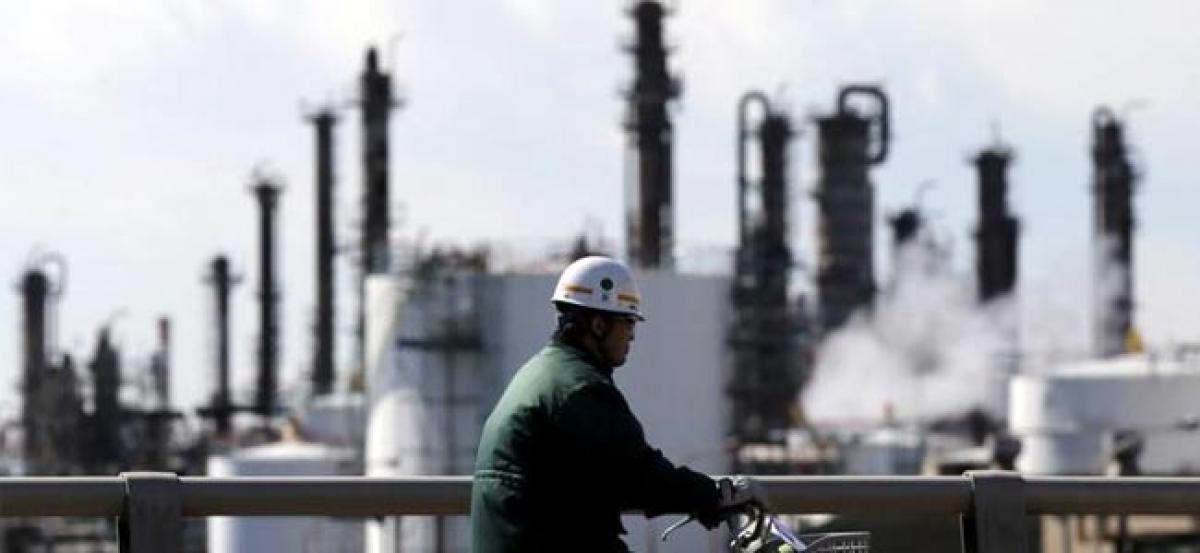Live
- First Impressions and Unboxing of the MacBook Pro M4: A Powerhouse for Professionals and Creators
- China Gears Up for Potential Trade War Amid Trump’s Tariff Threats
- Small Farmers Gain Less by Selling to Supermarkets: Study Reveals
- Why Despite the Controversy, America Is Anticipating the Mike Tyson vs. Jake Paul Fight
- Sanju Samson and Tilak Varma Shine: Record-Breaking Feats in 4th T20I Against South Africa
- India Urges $1.3 Trillion Annual Climate Support for Developing Nations
- Bad air: 106 shuttle buses, 60 extra Metro trips planned to make Delhiites give up cars
- WHO reports declining monkeypox cases in Congo
- CM Attends Kotideepotsavam on Kartika Purnima
- PKL Season 11: Raiding trio of Devank, Ayan, Sandeep help Patna Pirates rout Bengal Warriorz
Just In

A closely watched central bank survey showed big Japanese manufacturers\' sentiment improved for the first time in six quarters to hit a one-year high, as falls in the yen and a pick-up in overseas growth brightened Japan\'s economic prospects.
TOKYO: A closely watched central bank survey showed big Japanese manufacturers' sentiment improved for the first time in six quarters to hit a one-year high, as falls in the yen and a pick-up in overseas growth brightened Japan's economic prospects.
The Bank of Japan "tankan" survey published on Wednesday found companies also maintained their upbeat spending plans, reinforcing market expectations that the central bank will hold off on expanding monetary stimulus in the coming months.
Service-sector confidence, however, was unchanged from three months ago as bad weather hurt private consumption, the survey showed, underscoring the fragile and patchy nature of recovery in the world's third largest economy.
The headline index measuring big manufacturers' business sentiment rose to plus 10 from plus 6 three months ago, the tankan survey showed, matching a median market forecast and hitting the highest level since December 2015.
"Manufacturing sentiment is doing well, reflecting a recovery in global trade," said Hidenobu Tokuda, senior economist a Mizuho Research Institute.
"I think the economy will continue to grow due to exports and public works spending. The chance of additional monetary easing has receded."
The BOJ is likely to keep monetary policy steady and give a more upbeat view of the economy at next week's rate review, reflecting brighter prospects for global trade, sources have told Reuters.
Auto and machinery makers' sentiment brightened in the survey, which was taken days after the U.S. election last month, suggesting that sharp yen falls triggered by Donald Trump's election to president built up hopes for higher earnings.
The survey found big firms plan to increase capital expenditure by 5.5 percent for the current fiscal year to March 2017, slightly below projections made three months ago, but still in line with downward revisions that tend to occur at year-end, analysts say.
"Capital spending held firm. Taken together, this tankan confirmed a gradual economic recovery, which backs up the BOJ's upbeat view," said Takeshi Minami, chief economists at Norinchukin Research Institute.
"It should be taken as another factor for the central bank to stand pat on policy for the time being."
DRAG FROM CONSUMPTION
An index measuring corporate price-setting behaviour improved slightly, a sign more companies were raising the prices of their goods to pass on higher raw material costs to consumers.
Despite more than three years of aggressive money printing by the BOJ, Japan's economy has failed to emerge sustainably from the doldrums as soft global demand and slow wage growth weigh on exports and private consumption.
The tankan showed big non-manufacturers' mood was flat from three months ago at plus 18, as sentiment soured among restaurants, retailers and hotels hurt by soft consumption.
Big manufacturers and non-manufacturers expect business conditions to worsen slightly in the coming three months, suggesting that companies remain cautious on whether positive market trends will continue.
But recent data offer signs of hope. Japanese firms' order books expanded in November on robust Asian demand, and consumption edged back up after slumping as bad weather kept shoppers at home.
Big manufacturers based their profit estimates on an assumed average dollar/yen rate of 104.90 for the current fiscal year.
That is a stronger yen estimate than current levels around 115 yen, suggesting that corporate profits may be revised up sharply if the current weak-yen trend continues, analysts say.
The tankan also showed labour shortages were intensifying. An index measuring small firms' staffing conditions hit levels unmatched since 1992, when the economy was booming from an asset-inflation bubble.

© 2024 Hyderabad Media House Limited/The Hans India. All rights reserved. Powered by hocalwire.com







